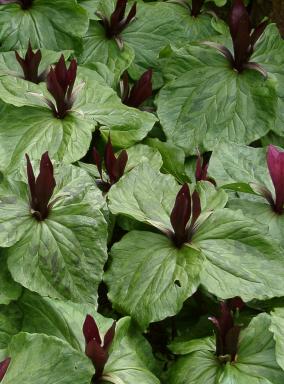
Trillium chloropetalum, also known as giant trillium, giant wakerobin, or common trillium, is a species of flowering plant in the family Melanthiaceae. It is endemic to the western U.S. state of California, being especially frequent in and around the San Francisco Bay Area.
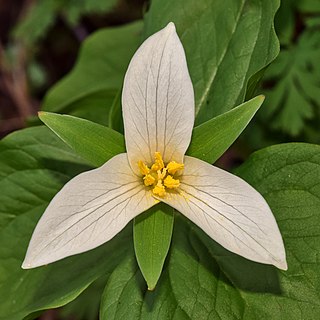
Trillium ovatum, the Pacific trillium, also known as the western wakerobin, western white trillium, or western trillium, is a species of flowering plant in the family Melanthiaceae. It is found in western North America, from southern British Columbia and the tip of southwestern Alberta to central California, east to Idaho and western Montana. There is an isolated population in northern Colorado and southern Wyoming.

Trillium luteum, the yellow trillium or yellow wakerobin, is a species of flowering plant in the bunchflower family Melanthiaceae. It is a member of the Trillium cuneatum complex, a closely related group of sessile-flowered trilliums. The species is endemic to the southeastern United States, especially in and around the Great Smoky Mountains of eastern Tennessee and western North Carolina.

Trillium discolor, the mottled wakerobin, pale yellow trillium, or small yellow toadshade, is a species of flowering plant in the family Melanthiaceae. It is native to areas of the Savannah River drainage system of Georgia, North Carolina and South Carolina such as Steven's Creek Heritage Preserve and Lake Keowee. It is found along moist stream banks in upland woods, on acidic to basic soils.

Trillium viridescens, also known as the Ozark trillium or tapertip wakerobin, is a species of flowering plant in the family Melanthiaceae. It is found in parts of Arkansas, Missouri, Oklahoma, Kansas, Texas and Louisiana. It usually grows in rich deciduous forests and mountain ranges where the soil is clayey and calcareous.

Trillium cuneatum, the little sweet betsy, also known as whip-poor-will flower, large toadshade, purple toadshade, and bloody butcher, is a species of flowering plant in the family Melanthiaceae. It is a member of the Trillium cuneatum complex, a subgroup of the sessile-flowered trilliums. It is native to the southeastern United States but is especially common in a region that extends from southern Kentucky through central Tennessee to northern Alabama. In its native habitat, this perennial plant flowers from early March to late April. It is the largest of the eastern sessile-flowered trilliums.
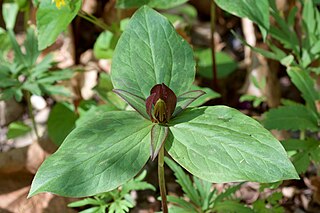
Trillium sessile is a species of flowering plant in the bunchflower family Melanthiaceae. The specific epithet sessile means "attached without a distinct stalk", an apparent reference to its stalkless flower. It is commonly known as toadshade or toad trillium. It is also called sessile trillium or sessile-flowered wake-robin, however it is not the only member of the genus with a sessile flower.

Trillium decipiens, also known as Chattahoochee River wakerobin or deceiving trillium, is a spring-flowering perennial plant. It occurs mostly near the Chattahoochee River in Alabama, Florida and Georgia. Scattered populations are found elsewhere in these three states, all within the Atlantic Coastal Plain or Gulf Coastal Plain. Rich deciduous woods of bluffs, ravines, and alluvial land provide its most favored habitat.

Trillium nivale, the snow trillium or dwarf white trillium, is a species of flowering plant in the family Melanthiaceae. It is native to parts of the east and midwest United States, primarily the Great Lakes States, the Ohio Valley, and the Upper Mississippi Valley, as far north as central Minnesota.
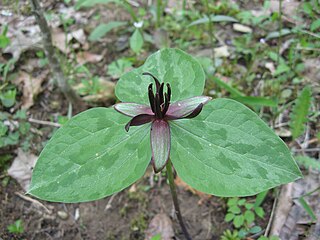
Trillium stamineum, the twisted trillium, also known as the Blue Ridge wakerobin, is a species of flowering plant in the family Melanthiaceae. It is native to the southeastern United States, in Alabama, Mississippi and Tennessee. Its natural habitat is calcareous woodlands.

Trillium sulcatum is a species of flowering plant in the bunchflower family Melanthiaceae. It is a member of the Erectum group, a group of species typified by Trillium erectum. The specific name sulcatum means "furrowed, grooved, or sulcate", which describes the tips of the sepals. It is most abundant on the Cumberland Plateau in central Tennessee and eastern Kentucky where it blooms in April and May. The species is commonly known as the southern red trillium or furrowed wakerobin.

Trillium pusillum is a species of flowering plant in the family Melanthiaceae known by the common names dwarf trillium, least trillium and dwarf wakerobin. It is native to the southeastern and south-central United States from Oklahoma to Maryland.

Trillium foetidissimum, also known as the Mississippi River wakerobin, stinking trillium, or fetid trillium, is a species of flowering plant in the family Melanthiaceae. It is found along the Louisiana–Mississippi border in a variety of habitats.

Trillium albidum is a species of flowering plant in the bunchflower family Melanthiaceae. It is the only trillium characterized by a stalkless white flower. The species is endemic to the western United States, ranging from central California through Oregon to southwestern Washington. In the San Francisco Bay Area, it is often confused with a white-flowered form of Trillium chloropetalum. In northern Oregon and southwestern Washington, it has a smaller, less conspicuous flower.

Trillium recurvatum, the prairie trillium, toadshade, or bloody butcher, is a species of perennial herbaceous flowering plant in the family Melanthiaceae. It is native to parts of central and eastern United States, where it is found from Iowa south to Texas and east to North Carolina and Pennsylvania. It grows in mesic forests and savannas, often in calcareous soils. It is also known as bloody noses, red trillium, prairie wake-robin, purple trillium, and reflexed trillium, in reference to its reflexed sepals.
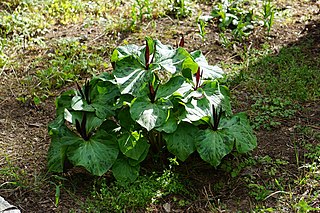
Trillium angustipetalum, with the common name is narrowpetal wakerobin, is a species of Trillium, plants which may be included within the Liliaceae or the newer family Melanthiaceae.
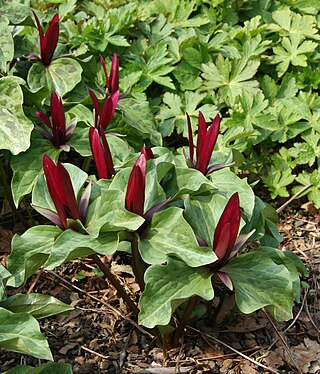
Trillium kurabayashii is a species of flowering plant in the bunchflower family Melanthiaceae. The species is endemic to the western United States, occurring in extreme southwestern Oregon, northwestern California, and the Sierra Nevada of northern California. It was first described by John Daniel Freeman in 1975. The specific epithet kurabayashii honors Masataka Kurabayashi, a Japanese cytologist and population geneticist who first postulated the taxon’s existence. It is commonly known as the giant purple wakerobin, a reference to its conspicuously large, dark purple-red flower, one of the largest of any sessile-flowered trillium.
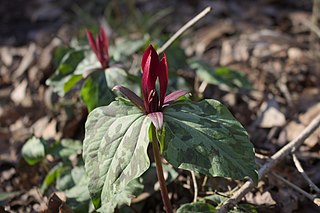
Trillium maculatum, the spotted wakerobin or spotted trillium, is a species of flowering plant in the family Melanthiaceae. It is a member of the Trillium cuneatum complex, a closely related group of sessile-flowered trilliums. The species is endemic to the southeastern United States, ranging across Alabama, Georgia, South Carolina, and northern Florida.

Trillium ludovicianum, the Louisiana wakerobin or Louisiana trillium, is a species of flowering plant in the family Melanthiaceae. It is found only in the south-central United States, in Louisiana, Mississippi, and eastern Texas.
Trillium viride, commonly called the wood wakerobin, is a species of flowering plant in the family Melanthiaceae. It is found in the central United States, in certain parts of Missouri and Illinois. The specific epithet viride means "youthful" or "fresh-green", an apparent reference to the color of the plant's flower petals. For this reason, it is also called the green trillium, not to be confused with other green-flowered trilliums such as T. viridescens and the green form of T. sessile, both of which are found in Missouri.



















